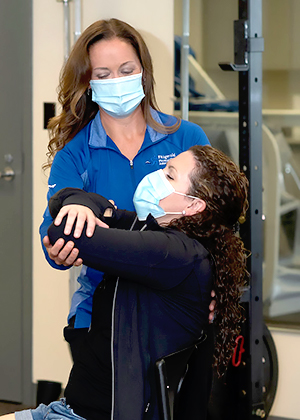The McKenzie Method®
As physical therapists, we want to be at our best and give our patients the best possible care. Therefore, at Fitzgerald PT, we offer the McKenzie Method® of mechanical diagnosis and therapy® (MDT).
What is it?
The McKenzie Method of MDT is a reliable assessment process intended for all musculoskeletal problems, including pain in the back, neck and extremities (i.e., shoulder, knee, ankle etc.), as well as issues associated with sciatica, sacroiliac joint pain, arthritis, degenerative disc disease, muscle spasms and intermittent numbness in hands or feet. If you are suffering from any such issues, then an MDT assessment may be right for you!
Developed by world-renowned expert physiotherapist Robin McKenzie in the 1950s, this well-researched, exercise-based approach of assessment, diagnosis and treatment uses a comprehensive and clinically reasoned evaluation of patients without the use of expensive diagnostic imaging (e.g. x-rays and MRIs).
The treatment principles of the McKenzie Method promote the body's potential to repair itself and do not involve the use of medication, heat, cold, ultrasound, injections or surgery. McKenzie allows patients to learn the principles and empowers them to be in control of their own symptom management, which can reduce dependency on medical intervention.

Goals of the treatment:
- Accurately understand the patient's presentation and behavior of symptoms.
- Determine the most appropriate and effective treatment plan.
- Eliminate symptoms and restore full function.
- Empower the patient to self-treat and prevent recurrences.
- Help inform patients if other medical advice or testing is needed.
How does it work?
MDT is comprised of four primary steps:
MDT begins with the clinician taking a detailed history about your symptoms and how they behave. You will be asked to perform certain movements and rest in certain positions. The main difference to most other assessments is the use of repeated movements rather than a single movement. How your symptoms and range of movement changes with these repeated movements provides the clinician with information that they can use to categorize your problem.
Each syndrome is addressed according to its unique nature, with specific mechanical procedures, including repeated movements and sustained postures.
Using the information from the assessment, the clinician will prescribe specific exercises and advice regarding postures to adopt and postures to temporarily avoid. If your problem has a more difficult mechanical presentation, a qualified MDT clinician may need to add hands-on techniques until you can self-manage. The aim is to be as effective as possible in the least number of sessions. Treatment that you can perform five or six times a day is more likely to be effective in a shorter period of time than treatment administered by the clinician once or twice per week. The emphasis is on you, the patient, being actively involved. This can minimize the number of visits to the clinic. Ultimately, most patients can successfully treat themselves when provided with the necessary knowledge and tools.
By learning how to self-treat the current problem, you gain knowledge on how to minimize the risk of recurrence. You can also rapidly deal with symptoms if they recur, putting you in control of your treatment safely and effectively. Persisting problems are more likely to be prevented through self-maintenance than by passive care.
The McKenzie Method gives patients control of their pain and empowers them to get back to the life they love.
Have questions regarding this method or would like to talk to someone to determine if this treatment is right for you? We specialize in this method and would be happy to help!
Ready to
get started

